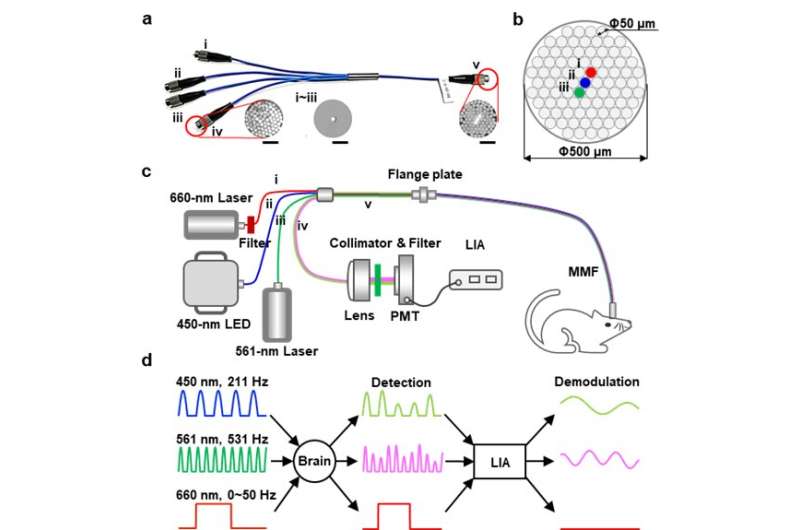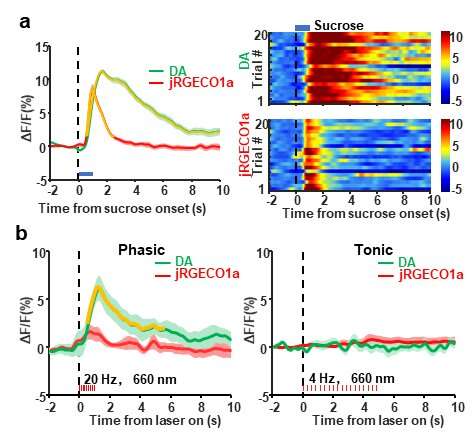Figure 1 All-fiber-transmission multi-color recording and optogenetics system. (a) An image of the four-branch fiber bundle. (b) Diagram of the four-branch fiber bundle common branch v. (c) Schematic diagram of the multi-function fiber photometry system constructed with the four-branch fiber bundle. (d) Schematic diagram of the lock-in amplifier for the multi-function fiber photometry system. Credit: Compuscript Ltd
A new publication from Opto-Electronic Advances discusses all-fiber transmission photometry for simultaneous optogenetic stimulation and multi-color neuronal activity recording.
Understanding the structure and function of the brain is the most challenging scientific frontier in the 21st century as more and more countries participate in the brain initiative. The neuron is the basic structural and functional units of the nervous system, and their activity state is closely related to the physiological functions of the brain. These neurons are interconnected by synapses to carry out a specific function, which form neural circuits and then form large-scale brain networks further. In brain science research, manipulating and real-time monitoring the activities of cell-type specific neuron efficiently with low damage and high spatiotemporal resolution during animal behavior are fundamental work for exploring the functional connectivity, information transmission, and physiological functions of neural circuits in vivo, also the basis for the research and treatment of brain diseases.
In the current study of neural circuits, it is necessary to manipulate and monitor the activity of neurons to explore the causal investigations of neural circuits and behavioral function. Electrophysiological recording and optical detection are the major methods of monitoring the activities of neurons, while the manipulation of neuronal activity is generally achieved by optogenetics. However, previous techniques or systems to optogenetically manipulate or monitor neuronal activity in behaving animals are mostly separated and work independently. In order to investigate neuronal activities and behavioral function in neural circuit and the feedback responses of optogenetic manipulation, it is important to combine manipulating and monitoring technologies.
Figure 2 multi-color recording and optogenetic manipulation of neuronal activities in NAc of a freely moving mouse. (a) Simultaneous recording of dopamine dynamics and neuronal Ca2+ signals in the NAcLat of a freely moving mouse. (b)Simultaneous multi-color recording and optogenetic manipulation of neuronal activities in the NAc of a freely moving mouse. Credit: Compuscript Ltd
Fiber photometry has become increasingly popular among neuroscientists as a convenient tool for the recording of genetically defined neuronal populations in behaving animals. The brain exists various neurons, which can transmit information via synaptic junctions or neurotransmitters. The ability to optogenetically manipulate and multi-color monitor neuronal activity or neurotransmitter activity with cell-type specificity is indispensable for neuroscientists to study neural circuits in behaving animals. However, it is quite challenging to combine multi-color recording with optogenetics. Since the excitation spectrum of the commonly used opsin-sensors is close to the emission spectrum of the GFP-based and RFP-based GEFIs and considering that it is quite challenging to completely filter out optogenetic stimulation light with milliwatt, obvious artifacts from optogenetic stimulation are inevitable in a weak (pico watt) fluorescent signal during recording. Therefore, the traditional optical methods only support the monitoring of one type of neuronal activity when applying optogenetic manipulation at present.
The authors of this paper report an all-fiber-transmission photometry system for simultaneous optogenetic manipulation and multi-color recording of neuronal activities and the neurotransmitter release in a freely moving animal. They firstly demonstrated successful dual-color recording of neuronal Ca2+ signals and Dopamine dynamics in the NAc upon delivering an unexpected reward and the simultaneous optogenetic input from the upstream ventral tegmental region, which exists significant differences in the time course for reward or response intensity for optogenetic input.
By using a custom-designed multi-branch fiber bundle, the system can conveniently deliver all of the required light using optical fibers, making the system more robust for use in freely behaving experimental contexts and dual-color recording. This system has a more excellent light transmission performance than the traditional epi-fluorescence system. Moreover, there were no substantial channel crosstalk or stimulation artifacts for simultaneous multi-color recording of neuronal Ca2+ signals and neurotransmitter dynamics and precise optogenetic manipulations in freely moving animals.
More information: Zhongyang Qi et al, All-fiber-transmission photometry for simultaneous optogenetic stimulation and multi-color neuronal activity recording, Opto-Electronic Advances (2022). DOI: 10.29026/oea.2022.210081
Provided by Compuscript Ltd

























